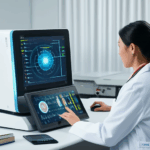“`html
Cloud Computing vs Edge Computing: Understanding the Key Differences
Introduction
Cloud computing and edge computing are two of the most transformative technologies in today’s digital landscape. While both play crucial roles in modern IT infrastructures, they serve different purposes and cater to distinct sets of requirements. Understanding the differences between these two technologies is essential for businesses and individuals looking to leverage the best solutions for their specific needs.
This article aims to provide a comprehensive overview of cloud computing and edge computing, highlighting their definitions, architectures, advantages, and disadvantages. We will also delve into the key differences between them and explore various use cases where each technology excels.
Cloud Computing
Definition
Cloud computing refers to the delivery of computing services—such as servers, storage, databases, networking, software, and intelligence—over the internet (“the cloud”). Instead of owning and maintaining physical hardware, users can access these resources on-demand, paying only for what they use. This model allows organizations to scale their IT infrastructure efficiently and cost-effectively.
Architecture
The architecture of cloud computing revolves around large, centralized data centers equipped with powerful servers and robust networking capabilities. These data centers host virtualized resources that are accessible via the internet. Users can provision and manage these resources through web-based interfaces, enabling flexible and scalable IT operations.
Advantages
- Scalability: Cloud computing offers seamless scalability, allowing organizations to increase or decrease their resource allocation based on demand.
- Cost-effectiveness: By eliminating the need for on-premises hardware, cloud computing reduces capital expenditure and operational costs.
- Accessibility: Cloud services can be accessed from anywhere with an internet connection, providing flexibility for remote work and global operations.
Disadvantages
- Latency issues: Since data must travel over the internet to reach cloud servers, there can be delays in processing, especially for real-time applications.
- Security concerns: Storing sensitive data in the cloud raises privacy and security risks, particularly if proper encryption and access controls are not implemented.
Edge Computing
Definition
Edge computing is a distributed computing paradigm that brings computation and data storage closer to the location where it is needed—i.e., the edge of the network. By processing data locally, edge computing minimizes the need to transmit large amounts of data to central servers, thereby reducing latency and improving performance.
Architecture
The architecture of edge computing involves decentralized processing units located at the network edge, such as IoT devices, gateways, or local servers. These edge nodes perform computations and data filtering before sending critical information to central cloud servers. This approach ensures that only relevant data is transmitted, optimizing bandwidth usage and enhancing overall system efficiency.
Advantages
- Reduced latency: By processing data locally, edge computing significantly reduces the time it takes for data to travel between devices and central servers.
- Improved data privacy: Processing data at the edge reduces the amount of sensitive information that needs to be transmitted over the internet, enhancing privacy and security.
- Enhanced reliability: Edge computing provides redundancy by distributing processing tasks across multiple nodes, ensuring continuous operation even in case of network failures.
Disadvantages
- Limited processing power: Edge devices typically have less computational power compared to centralized cloud servers, which can limit their ability to handle complex tasks.
- Higher costs: Building and maintaining a distributed infrastructure can be more expensive than relying on centralized cloud services.
Key Differences
| Aspect | Cloud Computing | Edge Computing |
|---|---|---|
| Data Processing Location | Centralized data centers | Distributed edge nodes |
| Latency | Higher latency due to data transmission over the internet | Lower latency as data is processed locally |
| Bandwidth Usage | Higher bandwidth usage due to frequent data transfers | Lower bandwidth usage as only critical data is sent to the cloud |
| Scalability | Highly scalable, resources can be easily adjusted | Scalability is limited by the number of edge nodes |
| Cost Implications | Initial setup costs are lower, but ongoing maintenance can be higher | Higher initial investment due to distributed infrastructure |
| Security Considerations | Centralized security measures can be more effective | Decentralized security requires robust local protections |
Use Cases
Cloud Computing Use Cases
- Big Data Analytics: Cloud platforms provide the necessary compute and storage resources to process large datasets, enabling insights and decision-making.
- Software as a Service (SaaS): Cloud-based SaaS applications offer flexible and scalable software solutions without the need for on-premises installations.
- Infrastructure as a Service (IaaS): IaaS providers offer virtualized computing resources, allowing organizations to build and manage their own IT environments.
Edge Computing Use Cases
- Internet of Things (IoT) Devices: Edge computing enables real-time processing of sensor data from IoT devices, facilitating faster responses and improved efficiency.
- Autonomous Vehicles: Edge computing is crucial for processing sensor data in real-time, ensuring safe and efficient operation of autonomous vehicles.
- Real-Time Analytics: Edge computing supports real-time analytics by processing data locally, reducing latency and improving decision-making speed.
Conclusion
In summary, cloud computing and edge computing are complementary technologies that address different challenges in modern IT infrastructures. Cloud computing excels in providing scalable, cost-effective, and accessible resources, while edge computing offers reduced latency, improved data privacy, and enhanced reliability.
Choosing the right technology depends on specific business needs and use cases. For applications requiring centralized control and extensive processing power, cloud computing is often the better choice. However, for scenarios demanding low-latency and real-time processing, edge computing proves to be more advantageous.
By understanding the key differences between cloud computing and edge computing, organizations can make informed decisions and deploy the most appropriate solutions to meet their objectives.
“`


